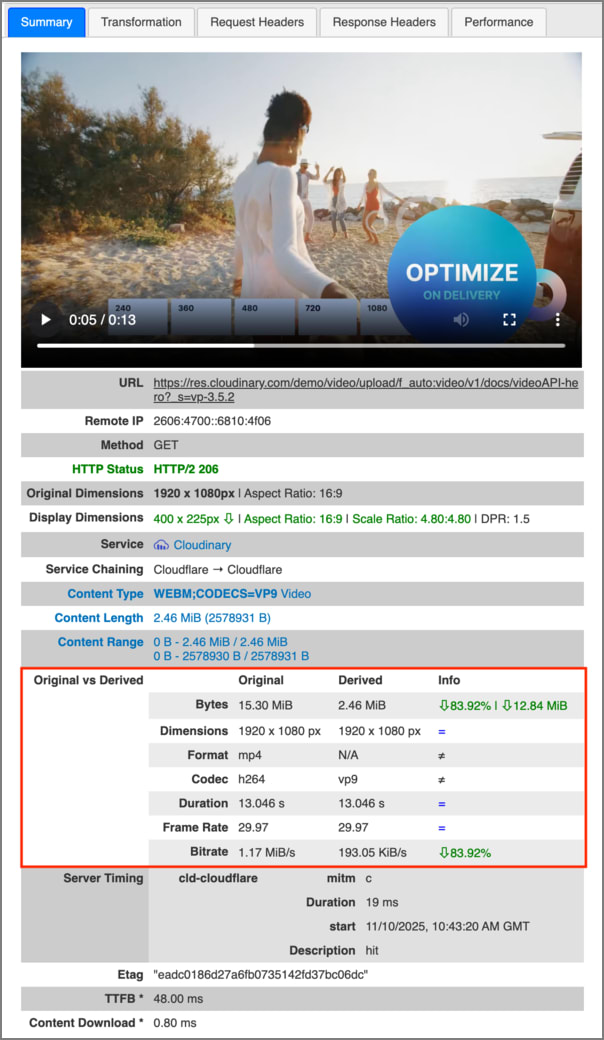Cloudinary Image & Video release notes: December 18, 2025
Last updated: Dec-18-2025
We publish Cloudinary Image and Video API release notes periodically to give you a quick overview of all the new features, enhancements, and fixes that we've recently released for Cloudinary developers. When relevant, they may also give sneak previews of upcoming features and/or other share important announcements.
Cloudinary Image
Automatic image enhancements
The new auto_enhance effect uses AI to automatically enhance an image by optimizing its quality based on the detected quality. If an image is already high quality, only minor adjustments are made. Otherwise, more aggressive enhancements are applied to improve the overall appearance, including noise reduction and detail enhancement.
Generative remove effect supports NSFW check
The generative remove effect (e_gen_remove in URLs) now supports a Not Safe For Work (NSFW) check. Cloudinary checks content that's generated in place of the removed object for appropriateness. If the NSFW check detects something inappropriate, the system blurs the delivered image.
You can contact support to disable this check if you believe it's too sensitive.
JPEGmini add-on sunset
The JPEGmini Image Optimization add-on is now fully deprecated and disabled. Any transformation URL that includes q_jpegmini will return an HTTP 400 error.
If you're an existing subscriber to this add-on, you should replace jpegmini usage with the automatic quality transformation (q_auto) to optimize image quality.
Contact support with any questions or requests for guidance.
Cloudinary Video
Advanced video player with custom controls for React Native
The React Native SDK now includes the CLDVideoLayer component, a comprehensive full-screen video player with customizable controls and advanced features.
Key features include:
- Flexible Button Positioning: Place custom buttons anywhere on the video overlay using compass-style positioning (North, South, East, West, and combinations)
- Horizontal/Vertical Button Layouts: Control how you arrange multiple buttons in button groups
- Share Functionality: Built-in sharing capabilities with customizable share handlers
- Playback Speed Control: Customizable playback speeds (0.5x, 1x, 1.25x, 1.5x, 2x, and more)
- Subtitle Support: Automatic HLS subtitle parsing and custom subtitle language configuration
- Quality Selection: Automatic HLS quality detection and manual quality selection options
- Full Screen Support: Landscape-optimized full screen mode with custom callbacks
- Bottom Button Bar: Additional button bar positioned below the seekbar
- Title and Subtitle Display: Show video titles and subtitles with customizable positioning
Asset and account management
Node.js SDK support for deleting and restoring assets by asset ID
The Node.js SDK now supports deleting and restoring assets by asset ID, enabling you to manage assets using their immutable identifiers for more consistent and reliable control.
Cloudinary VS Code extension on Open VSX
The Cloudinary VS Code Extension is now available on the Open VSX Registry (in addition to the VS Code Marketplace).
This ensures compatibility with open-source VSCode-forked IDEs, such as Cursor, Windsurf and any other IDE that supports Open VSX, and allows for automatic updates directly through the marketplace.
Cloudinary Media Inspector enhancements
The Cloudinary Media Inspector Summary tab now includes an Original vs Derived section, which shows you a comparison of the original asset stored in Cloudinary with the delivered, derived asset. This allows you to see how much your delivered assets are being optimized and the performance benefits you're gaining from using Cloudinary.
Learn more:
- Media Inspector overview and setup
- Media Inspector for image optimization
- Media Inspector for video optimization
Docs and demo apps
New Media Library Widget API reference
The Media Library widget embeds a compact version of the Cloudinary Media Library directly into your web application, providing most of the asset management capabilities including browse, search, select, upload, and organize.
The new Media Library Widget API reference provides comprehensive documentation for all widget methods, configuration options, callbacks, and events with practical code examples.
Register for notifications
Make sure you always know when we publish new release notes with the Image and Video release notes RSS feed:
Grab this RSS link to watch for new Image and Video release notes in your favorite RSS reader.
 Ask AI
Ask AI




